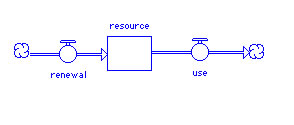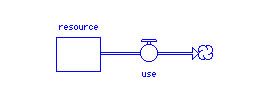Lecture 13: Energy Efficiency and Renewable energy sources
Tue, Feb 23, 2010
| |
1. energy efficiency |
|
| |
2. fundamental difference between non-renewable and renewable resources |
| |
3. examples of renewable energy |
| |
4. solar energy policy |
| |
5. assignment 2 |
| |
6. return quiz |
|
1. Energy Efficiency
negawatt - savings from a watt of power that you don't have to produce
|
2. Fundamental difference between non-renewable and renewable resources
def: resource - something that can be depleted
Even renewable energy sources could be depleted or used faster than they are being renewed.
systems diagram for these two
- renewable
- has the potential for steady state
- renewal rate = use rate

- non-renewable
- large stock can only be depleted

energy vs. water
If we covered 1.7% of the US with solar panels that were 10% efficient we could generate 3 terawatts of power which is enough to meet America's energy needs. (Technology Review Aug/Sept 2009 page 94)
But, water is not predicable or reliable - in India 450 million people live off rain fed agriculture and this year's weak monsoon has resulted in a massive shortcoming in food production (Economist Sept 12, 2009 - page 27)
|
3. powerpoint for lect 13
chapter 16 is very useful
|
4. Some energy policy
Oregonian article about trying to use incentives to promote solar PV generation
Mr Solar - calculations
simple accounting for solar panels
- calculate the number of KWatt*hrs produced over a year
- panel rating * number of hours of sun equivalent to the full rating (might be 4 per day)
- panel rating might be 10 panels at 80 watts/panel = 800 watts
- means you'd get 3.2 kwatt*hr per day or 1168 kwatt*hr per year
- at $0.12 per kwatt*hr thats only replacing $140 worth of electricity
- at about $5 per watt of solar panel = $4000 - it'd take a long time to pay back
- not counting all the other stuff needed (grid-tie, inverter, mounting brackets, etc)
Oregon incentives, tax breaks, and refund of some sort on the panels
Oregon Energy Trust
go to the calculator and the example payments
feed-in tarrif - the price electric companies have to pay you for the power you put into the grid
- suggested at $0.25 to 0.85 per kwatt*hr
- $20,000 for 3 kwatt system (which only produces 3*4hr/day*30day/mo) = 360 kw*hr/mo)
- which would pay back (360 * .25*12) or (360 *.85*12) = $1080 or $3672 per year making
- payback time is equal to about 20 years down to 5 1/2 years.
|
5. Assignment 2: Climate change and action
Consider our dilemma:
research vs. action
Distinction between "objective environmental science and scholarship" and "environmental activism"
- positivism - that facts and norms need to be separated, based in the belief that there a little atoms of truth (atomistic)
- David Orr - paraphrasing - Is it OK to be purely objective but loose the planet you live on?
- investigator/scholar as partipant - how do you do that in a non-biased way?
Perkins' definition of understanding
different types of problems and action that can be taken
A philosophically and intellecutally satisfying approach is offered by Norton (2005)
scientific adaptive management
|
6. Hand back quiz
comments and questions
|


![]()